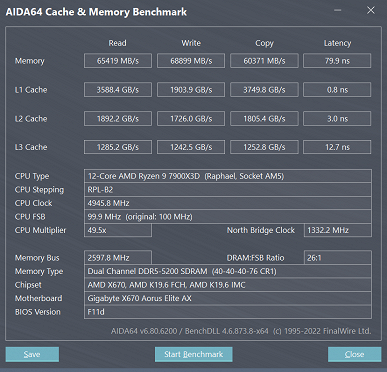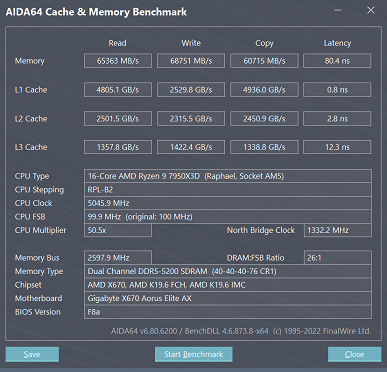Many readers may be surprised by the review of the Ryzen 9 7900X3D processor in 2024, since AMD announced the Ryzen 7000X3D series early last year. However, there are reasons for this. At first, we did not plan to test this controversial model at all, but when the opportunity did arise, we decided to take advantage of it to test our assumptions about the suboptimality of this model.
Let us recall that the X3D series processors combine additional cache memory with the computing cores of the Zen 4 architecture and are intended mainly for gaming and general-purpose systems. The history of such solutions began with the release of the unique Ryzen 7 5800X3D processor, which was distinguished by the presence of additional third-level cache memory in a separate chip attached to the computing one. This allowed the overall cache size to be increased, which in many games provided significant performance gains, even at lower core clock speeds. AMD then introduced this technology into three Ryzen 7000 series processors at once, releasing models with different numbers of cores and operating frequencies: the 8-core Ryzen 7 7800X3D, the 12-core Ryzen 9 7900X3D, and the flagship 16-core Ryzen 9 7950X3D. All of them are based on similar chips from the regular series, but with the addition of a die with 64 MB of L3 cache directly on the computing chiplet.
In our reviews of the X3D series processors, we noted that the Ryzen 9 7900X3D is not clear who it is aimed at. With its six cores with additional cache and six high-frequency cores, it is neither the most versatile nor purely gaming. For gaming, the 6+6 configuration is less preferable than the 8+0 of the 7800X3D due to the higher price and fewer cores with additional cache. For content creation applications, the 7900X3D is inferior to the 7950X3D due to its lower total core count. In terms of computing performance, the best chip in the AMD line is the Ryzen 9 7950X, the optimal gaming processor was the Ryzen 7 7800X3D, and the 7950X3D turned out to be the most versatile, providing both almost the best gaming performance and high performance in computing tasks. But the 7900X3D seemed to be neither one nor the other. But we now have the opportunity to see if it is as bad as we always thought.
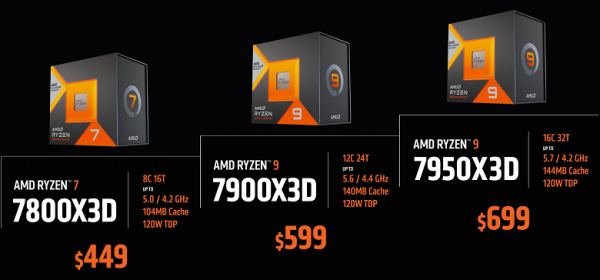
If the Ryzen 7 7800X3D is the successor to the successful Ryzen 7 5800X3D, then the Ryzen 9 7900X3D has no similar predecessors. If in the case of the 7800X3D and 7950X3D it was immediately clear what to expect from them, then with the 7900X3D the situation is not so obvious. We have to find out how it will perform in games with six cores with an increased cache and six regular ones, as well as in resource-intensive applications. We decided to evaluate how good this model is in both games and work applications compared to other current-generation processors and one of its competitors. The main goal is not to lag too far behind the 7800X3D and 7950X3D in games, and to be closer to the latter than to the former in applications.
This is no easy task, as the Ryzen 9 7950X3D is perhaps AMD's most versatile processor. It combines two dissimilar 8-core chiplets: one with a high frequency, but without additional cache, the other with an increased cache, but at a reduced frequency. This makes it suitable for both gaming and multi-threaded applications. We previously wrote that additional drivers are required to distribute threads across cores so that game threads can be executed on chiplet cores with L3 cache. However, the 7950X3D has eight of these cores, the 7800X3D has eight cores with additional cache, and the 7900X3D has only six of these gaming cores. So the question arises: will they be enough for games?
However, the Ryzen 9 7900X3D shouldn't be all bad. It can be on par with the Core i9-13900K and other X3D processors in most games, which is not bad. This processor is sold at approximately the price of Intel's previous flagship, so it needs to be compared with this processor. At the time of this article's publication, the 7900X3D was priced between the 7800X3D and 7950X3D, and may be the middle ground for those who need heterogeneous cores, but six cores are enough for gaming. Probably, the 7900X3D will be slightly inferior to the younger model in games, and the older one will definitely be faster in applications. We will check all this today.
Ryzen 9 7900X3D in the AMD processor line
In short, Ryzen 9 processors have two dies with compute cores and an input/output die (IOD). These computing crystals are heterogeneous: one of them is equipped with a 3D cache, and the second is the same as in regular Ryzen models, without additional cache. As a result, 96 MB of L3 cache is tied to the first die, and the standard 32 MB to the second. These chiplets are connected using Infinity Fabric Interconnect and have access to each other's memory, which somewhat slows down access when cores from two chiplets are running simultaneously. Another important feature is that the addition of a cache die limits the voltage and maximum clock speed, so this chiplet always runs at a reduced frequency.

The peculiarity of the Ryzen 9 7900X3D model is that both CCD computing crystals, which physically have 8 cores each, have two disabled cores — as a result, there are 6 active cores of each type. This differentiates it from the 7800X3D, which has one active 8-core chiplet, and the 7950X3D, which has two full 8-core chiplets. Optimal performance requires PPM Provisioning and V-Cache Performance Optimizer software drivers, which help the Windows operating system use the most suitable CCD kernels for specific tasks, providing better computing and gaming performance.
Overall, the Ryzen 9 7900X3D has 12 Zen 4 cores and a base power level similar to other X3D models of this generation — 120 W continuously, with a maximum Package Power Tracking (PPT) level of 162 W. The processor's computing cores have a base frequency of 4.4 GHz, and the turbo frequency differs for two dissimilar chiplets. A frequency of about 5.0 GHz is the limit for computing crystals with 3D V-Cache, and the second chiplet without cache can operate at a frequency of up to 5.6 GHz.
| Model | Cores | Streams | Base frequency, GHz | Turbo frequency, GHz | L3 cache, MB | Energy consumption, W | Rec. price, $ |
|---|---|---|---|---|---|---|---|
| Ryzen 9 7950X3D | 16 | 32 | 4.2 | 5.7 | 128 | 120/162 | 699 |
| Ryzen 9 7950X | 16 | 32 | 4.5 | 5.7 | 64 | 170/230 | 589 |
| Ryzen 9 7900X3D | 12 | 24 | 4.4 | 5.6 | 128 | 120/162 | 599 |
| Ryzen 9 7900X | 12 | 24 | 4.7 | 5.6 | 64 | 170/230 | 448 |
| Ryzen 9 7900 | 12 | 24 | 3.6 | 5.4 | 64 | 65/88 | 460 |
| Ryzen 7 7800X3D | 8 | 16 | 4.2 | 5.0 | 96 | 120/162 | 449 |
| Ryzen 7 7700X | 8 | 16 | 4.5 | 5.4 | 32 | 105/142 | 341 |
| Ryzen 7 7700 | 8 | 16 | 3.6 | 5.3 | 32 | 65/88 | 329 |
| Ryzen 5 7600X | 6 | 12 | 4.7 | 5.3 | 32 | 105/142 | 241 |
| Ryzen 5 7600 | 6 | 12 | 3.8 | 5.1 | 32 | 65/88 | 230 |
Let's refresh our memory on the characteristics of the main part of the Ryzen 7000 processor line, including regular models without 3D cache and versions with additional cache memory crystals. The Ryzen 9 7900X3D is a complete analogue of the 7900X model without the 3D prefix, featuring additional L3 cache, but a reduced base frequency and power consumption levels (long-term and maximum). Due to the additional crystal with cache, it was necessary to limit the clock frequency and voltage of half of the processor's processing cores. The power consumption level of the 7900X3D is 120/162 W, while the regular 7900X is 170/230 W, which gives the latter more opportunities to increase the frequency and operate longer in this mode.
Like the rest of the series, the Ryzen 9 7900X3D offers 28 PCIe 5.0 lanes, which compares favorably with the 16 5.0 lanes and 12 4.0 lanes of competing processors. Only DDR5 memory is supported, unlike Intel solutions of the last two generations, which also support DDR4. Officially, all Ryzen 7000s work with DDR5-5200 memory, which is slightly better than the 12th generation Intel Core, but slightly worse than the 13th and 14th. However, Zen 4 processors work optimally with modules with an effective frequency of 6000-6200 MHz and low latency, including XMP/EXPO profiles. Higher memory frequencies do not make sense, since the memory controller will switch to 2:1 mode, which will negatively affect performance and is not compensated by increasing the frequency.

The Ryzen 9 7900X3D looks quite interesting for general purpose systems, especially if they are also intended for gaming. For work tasks, the Ryzen 9 7950X, which costs about the same, is better suited. AMD initially set the price for the Ryzen 9 7900X3D at $599, which is even slightly more than the Ryzen 9 7950X without the additional die with cache. Now this 16-core processor has fallen in price, but it still remains the closest in price to the model under consideration. Among the competitors from Intel, the direct competitor in price is the flagship of the previous line — Core i9-13900K, as well as partially the Core i7-14700K from the current generation, which costs slightly less than both.
Like most high-end AMD processors, the boxed version of the Ryzen 9 7900X3D comes without a cooling system. For processors with additional cache memory, AMD has lowered the temperature limit to 89°C — it is safe for the CPU during long-term operation, after which the processor begins to reduce core frequency and performance. Therefore, good cooling is especially important for X3D processors. Even with reduced demands, we recommend using a high-quality liquid cooling system, since processor performance under high load depends on its efficiency. Let's remember that many coolers for the AM4 socket will fit the new AM5 socket, but only those that use AMD's native mount and backplate, and not their own mounts, as is often the case with advanced air and liquid cooling systems.
It is also worth considering not only the levels of heat dissipation and power consumption, but also the design features of the series processors. The Ryzen 7000 cover area is small and has cutouts along the edges, which reduces the contact area with the heatsink. Additionally, heat transfer is degraded due to the thick heat distribution cover and the small area of hot crystals underneath. Despite the fact that the 7900X3D has two cores disabled in both computing crystals, it does not heat up much less than the flagship 7950X3D model.
As for integrated graphics, all integrated graphics cores in the Ryzen 7000 processors are the same and consist of only two computing units of the RDNA 2 architecture. This is not enough for modern games at decent resolutions and with high graphics settings, so the integrated GPU is only suitable for office work without active use 3D graphics or for running old and undemanding games. A review of integrated GPUs is planned, and now we are moving on to tests of the Ryzen 9 7900X3D processor and its competitors and neighbors in the line.
Performance testing
Test systems and conditions
- Processors:
- AMD Ryzen 9 7900X3D (12 cores/24 threads, 4.4 — 5.6 GHz)
- AMD Ryzen 9 7950X3D (16 cores/32 threads, 4.2 — 5.7 GHz)
- AMD Ryzen 7 7800X3D (8 cores/16 threads, 4.2 — 5.0 GHz)
- Intel Core i9-13900K (8P+16E cores/32 threads, 3.0—5.8 GHz)
- Cooling system: AeroCool Mirage L360 (LCS 3×120 mm, 2300/1800 rpm)
- Motherboards:
- Gigabyte X670 Aorus Elite AX (AM5, AMD X670)
- ASRock Z790 LiveMixer (LGA1700, Intel Z790)
- RAM:
- 32 GB (2x16 GB) DDR5-5200 CL40 G.Skill Ripjaws S5 (F5-5200U4040A16GX2-RS5W)
- Video card: Sapphire Radeon RX 6800 XT (16 GB)
- Drive: Kingston KC2000 SSD 2 TB (SKC2000M8/2000G)
- Power supply: Corsair RM750 (80 Plus Gold, 750 W)
- Operating system: Microsoft Windows 11 Pro (22H2)
To test current processors, we used high-performance motherboards for each of the two competing platforms, providing them with a sufficient amount of RAM operating at close to the optimal frequency — within the capabilities of the existing modules. For Ryzen 7000 series processors and Intel solutions of the last two generations, DDR5-5200 memory was used. Memory settings for all systems were taken from the XMP profile, and the processor's power consumption limits corresponded to their specifications, and not to the motherboard manufacturer's settings, which may differ, especially in the case of Intel processors.
All three processors of the X3D line took part in the tests: Ryzen 9 7950X3D with 16 heterogeneous cores on two chiplets, today’s hero with 12 cores is the Ryzen 9 7900X3D, as well as the eight-core Ryzen 7 7800X3D with one chiplet, on which an additional crystal with a cache is installed. Based on the comparative results, it will be clear to what extent these processors are justified in various tasks, for which tasks the cache is important, for which a higher clock frequency is needed, and how many cores are needed to perform certain tasks. For price and class comparison, we chose the Core i9-13900K from Intel, which is a direct price competitor for the Ryzen processor in question, judging by current retail prices.
For processor tests, we chose a previous generation AMD video card — Radeon RX 6800 XT. At the time of testing, the author did not yet have new video cards of the Radeon RX 7900 and GeForce RTX 40 series, but the Radeon RX 6800 XT has sufficient performance for testing at low resolutions and provides greater rendering speed when the CPU is loaded compared to competitors from Nvidia. same release time. This is important for gaming tests, the results of which will be discussed in a separate section.
Synthetic tests
Memory and caching performance
The DDR5 memory bandwidth used in the Ryzen 7000 family has increased significantly compared to DDR4 in previous generation processors. However, adding additional cache memory to one of the chiplets in the Ryzen 9 7900X3D did not provide any advantage in this regard. The situation remains the same: if we compare the bandwidth of the processor in question with the performance of the flagship Intel processor, even of the previous generation, the competitor’s solution is much faster in all respects, especially in the speed of reading and copying from memory. We have known for a long time that the efficiency of the DDR5 controller of AMD processors is lower, judging by the results of synthetic memory tests from the AIDA64 and Sandra packages.
Equal conditions were created for all processors — DDR5-5200 memory operating mode. However, in terms of throughput, it is the Intel processor that wins. Screenshots from AIDA64 clearly show that the Intel processor has an advantage in memory bandwidth over all compared AMD processors. There is no particular difference in the latency of access to RAM — the performance of the Core i9 and all Ryzen models with DDR5 memory are close. Let's evaluate the same memory indicators in a visual diagram:

Both Ryzen 9 models with DDR5-5200 achieve read speeds of around 65 GB/s, which is slightly higher than the 58 GB/s of the 8-core 7800X3D. For comparison, an Intel processor with the same memory and identical settings from the XMP profile reaches 85 GB/s. The situation with memory writing is better: all Ryzens have similar results, and the Core i9 is only slightly faster. This confirms that AMD's DDR5 memory controller is inferior to Intel's, which affects the performance of Zen 4 architecture processors in some tests. Additional cache memory in AMD processors significantly improves their gaming performance.
The growth of computing power has significantly outpaced the increase in memory performance for several decades. Processors began to use increasingly complex caches to provide increased performance without being constrained by comparatively slow memory. Intel and AMD processors use a three-level caching scheme: each core has a small L1 cache and its own larger second-level (L2) cache to reduce latency when accessing the third level of cache (L3). The L3 cache is several megabytes in size and is used by several cores at once. In cache memory, both latency and throughput are important.

An L3 cache on a separate die increases the overall capacity, but also adds data access latency. The latencies of the cache subsystem of the first two levels are similar for all Ryzen processors, but differ slightly due to different clock frequencies and measurement errors. In the Zen 4 architecture, AMD reduced the latency of the built-in L3 cache to less than 10 ns, but the addition of a separate die with additional L3 cache in X3D processors led to an increase in latencies to approximately 12-13 ns. Despite this, the AMD processor we're reviewing today still delivers better latencies than the Intel Core i9-13900K at all cache levels.
In addition to cache access latency, cache throughput is also important, especially for vectorized code. While the core caches in Zen 4 remain similar to Zen 3 and Zen 2, L1 and L2 throughput has been improved by increasing clock speeds. The throughput of the L3 built into the compute chiplets has also improved slightly, thanks to an increase in the queue size between L2 and L3, which helps reduce latency. Let's look at the results of the throughput test of all levels of cache memory from AIDA64.

We've already mentioned that the Zen 4 architecture's cache is faster at all levels compared to the previous generation, especially the L3 cache. When comparing three Ryzen models with additional L3 cache, the less powerful models have lower throughput across all cache levels due to fewer compute cores—the total throughput across all cache blocks is shown. Thus, it is consistent with our expectations and theory.
As for the Core i9-13900K processor chosen as a competitor, it has a noticeably more powerful L1 cache, but is significantly inferior in L2 cache bandwidth. The situation with the third cache level is ambiguous — the reading speed is higher, but writing and copying are slower.
Synthetic tests Sandra
Synthetic benchmarks from packages like Sandra and AIDA64 provide useful information for assessing low-level performance on specialized tasks. While these tests claim to be universal, they are especially useful for comparing relative performance across different tasks and calculating an overall CPU Overall score, which is calculated based on all test results.
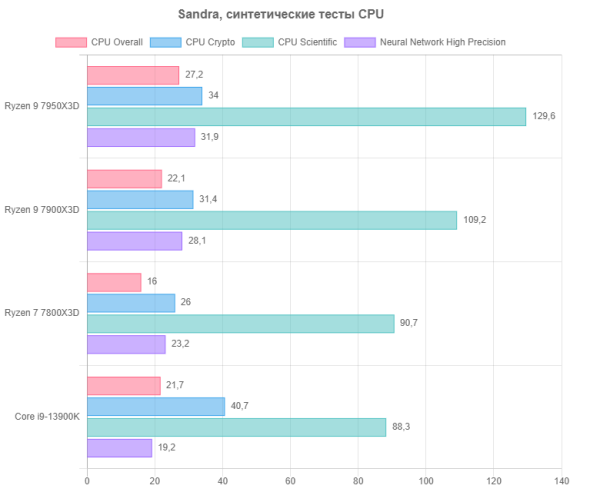
In the test set, the Ryzen 7000X3D processors were arranged in the order of their line, depending on the number of processing cores, and the strange 6+6 configuration did not have a negative impact on the performance of today's hero. It is ahead of the 7800X3D, but inferior to the older model, which is fully in line with expectations. The conditional competitor, Core i9-13900K, has similar performance in half of the tests to the 7800X3D model, in one case it is close to the 7900X3D, and in the field of cryptography it is ahead of all Ryzen processors. However, results in other subtests of the same test suite usually show a more significant advantage for AMD processors, especially in multimedia tasks.
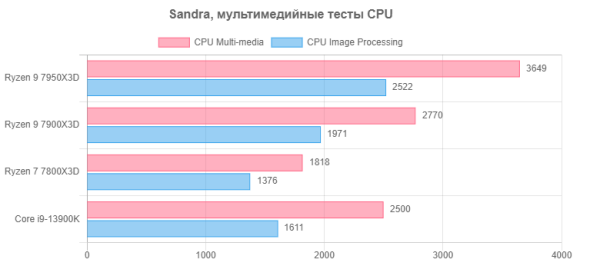
These tests demonstrate compute performance in media processing, where the 7900X3D once again ranks between the 7800X3D and 7950X3D, although its core configuration may not seem optimal from a theoretical perspective. Intel's recent flagship was unable to get ahead in these tests, despite the large number of cores and high frequencies — it lagged behind both Ryzen 9 models in both subtests, although it managed to outpace the eight-core model. These specialized tests especially highlight the strength of AMD processors. Next, let's look at the results from another universal package — AIDA64.
Synthetic AIDA64 tests
These are also tests aimed at synthetically assessing performance in specific tasks. For example, CPU Queen uses integer operations to solve chess problems, and the AES test evaluates the encryption speed of the AES cryptographic algorithm.
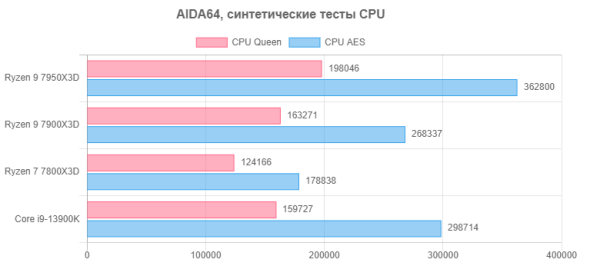
The addition of DDR5 memory support, higher clock speeds, and improved power limits significantly helped all of the new Ryzen processors in these tests, which was previously more difficult to achieve compared to Intel processors. The older Ryzen 9 is significantly ahead of everyone in these tests, while the Ryzen 9 7900X3D processor being reviewed today, for obvious reasons, lags behind it, but at the same time takes the lead compared to the Ryzen 7 7800X3D. The Core i9-13900K is quite close to the reviewed processor in the first test and even beats it in the second, which is related to cryptography (based on Sandra tests). Thus, AMD processors will have to continue to work on improving performance in such tasks.
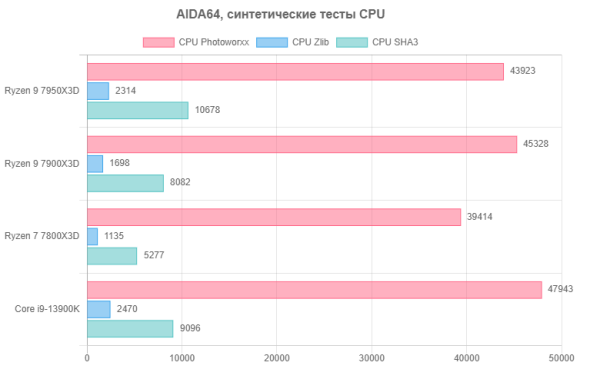
The first two subtests listed use integer operations for image processing and information compression, and SHA3 is another cryptographic algorithm. Intel processors tend to perform strongly, especially in image processing tests. The flagship of the previous generation Core i9 beats all Ryzen in the first two tests, but in the third it failed to cope with AMD's 16-core gaming flagship. In contrast, today's hero 7900X3D is inferior to the Core i9 in all three tests — the Intel processor shows up strongly in these tasks.
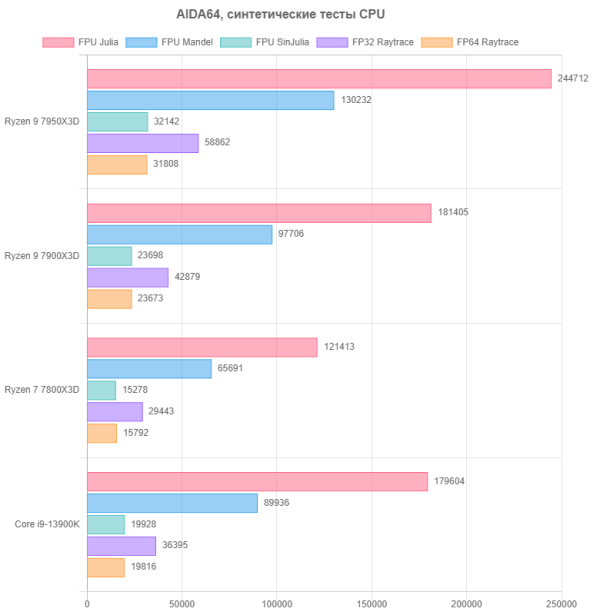
The most extensive set of subtests from AIDA64 includes floating point performance tests, including instructions from all SSE and AVX/AVX2 variants. AMD processors typically perform well in these tests, and the 12-core Ryzen 9 7900X3D performed well—in line with its theoretical performance, falling somewhere between 8- and 16-core models. In turn, the Core i9-13900K processor in these tests was not able to repeat the same impressive results as in the previous chart, and fell behind the 7900X3D in all subtests.
CPU-Z benchmark
This is another synthetic test that we included in this section — it evaluates the load on the cores and is closest to the rendering tests, and also allows you to conveniently compare single-threaded and multi-threaded processor performance. For Ryzen 7000 processors, a variant of the AVX-512 test was used, which contributed to a slight increase in performance compared to other CPUs.
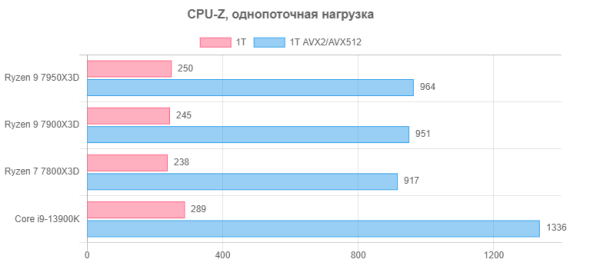
In terms of peak single-threaded performance, AMD processors continue to be inferior to Intel solutions, which is confirmed by the results of the CPU-Z test. The flagship Core i9 from the previous generation proved to be very powerful here, especially when using AVX instructions. Ryzen's low clock speed limits take a toll on their single-threaded performance, where the high turbo frequency limited to X3D processors is a deciding factor. The Ryzen 9 7900X3D is almost as good as the 7950X3D, and the 7800X3D is even slightly weaker. Let's move on to analyzing the multi-threaded load.
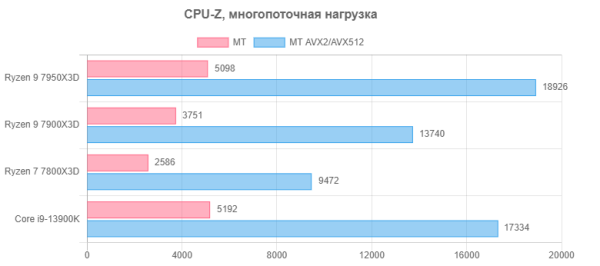
In terms of multi-threaded performance, the 12-core Ryzen 9 7900X3D with L3 cache on an additional die lags behind the 16-core model at about the same level as the 8-core 7800X3D is behind it. Thus, performance here strictly depends on the number of computing cores and their frequency. However, the Intel Core i9-13900K processor continues to outperform the processor we are considering both in conventional tests without AVX instructions and in variants with them. The Intel competitor is significantly superior to the 12-core X3D series processor both in tests without AVX2/AVX512 and with them. Although the use of AVX512 gives Ryzen processors an additional performance boost, it was not enough to compete with Intel. At the same time, the 16-core 7950X3D was able to show results that were closer to the Core i9 in one of the tests and approximately equal in the other, but this remains little consolation for AMD.
General tests
Let's move on to less theoretical tests that evaluate system performance in different types of application tasks and calculate an average value that reflects overall performance, for example, in the PCMark 10 package. This approach has its advantages (simplified assessment with a single value for the entire range of software) and cons (attempts to cover too wide a range of tasks, which may not always be ideal), however it is often used for testing processors.
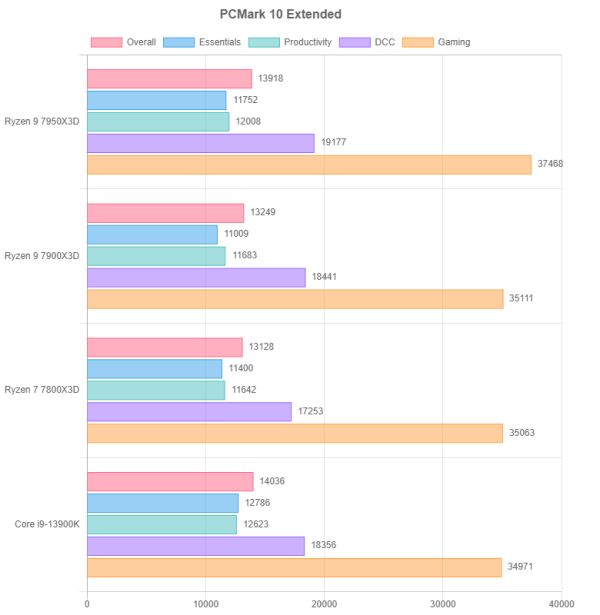
Based on past coverage, we know that most PCMark subtests do not use many threads and have little dependence on the number of processor cores. Overall performance mostly depends on CPU frequency and memory bandwidth, with the exception of the gaming subtest, where multi-core has a noticeable impact. Therefore, it is not surprising that all processors show very similar results both in overall performance and in individual categories, including office tasks.
However, there are still differences, and Intel is slightly ahead in terms of speed, with the exception of the gaming test. In digital content processing and office applications, the Core i9 leads, while the difference in the gaming test between the processors is more noticeable. It is interesting to note that the weak X3D processors showed almost identical results, comparable to the Intel solution, with the 16-core 7950X3D being the fastest. In general, in PCMark 10 the differences between processors are almost imperceptible.
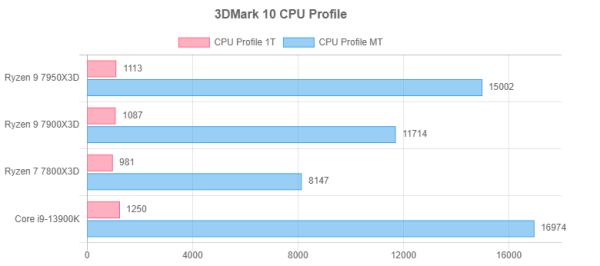
In the 3DMark CPU Profile performance test, which focuses on gaming rendering speed, the Ryzen 9 7900X3D was only ahead of the eight-core 7800X3D, trailing other processors in both single- and multi-threaded modes. However, due to the higher frequency limit, it ended up being closer to the 7950X3D than the 7800X3D.
When comparing the 12-core X3D processor to the recent flagship Intel Core i9-13900K, the Ryzen 9 7900X3D lost in both single-threaded and multi-threaded computing. This is explained by the fact that Intel processors are usually strong at single-threaded tasks due to high frequencies and efficient cores. The situation may be different in real-life games, as they often benefit from a larger L3 cache, but in core-intensive games such as strategy games, results may be similar to what we see in this test.
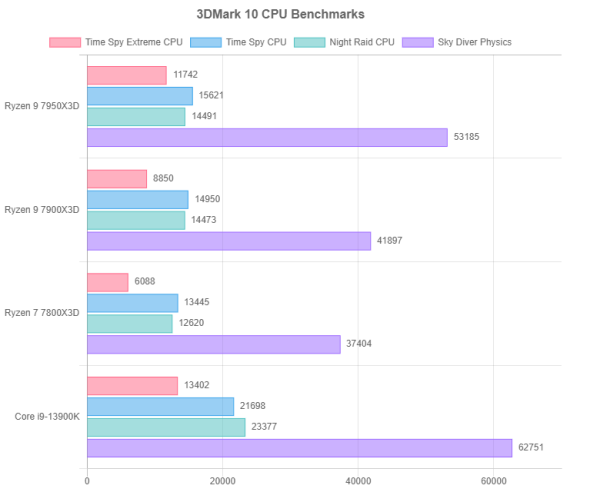
We took several CPU tests from the 3DMark suite, which often involve physics calculations that can utilize multi-threading to varying degrees of efficiency. The Ryzen 9 7900X3D generally performs as expected, although in some cases it comes close to the 7950X3D (for example, in the Night Raid test), and sometimes closer to the 7800X3D, which may seem surprising (for example, in the Sky Diver test), but overall it is where something between them.
The Core i9 rival performs better than the AMD processor we're reviewing today in all of these tests because these types of workloads are better suited to Intel processors thanks to their high clock speeds and hybrid architecture with more processing cores.

The last test in this section is the JetStream 2.0 browser benchmark, which measures the performance of code execution in JavaScript and WebAssembly. For testing, we used an updated version of Microsoft Edge running on the Chromium engine. This test does not make heavy use of multithreading and is highly dependent on the processor clock speed, especially in turbo mode.
It's positive that the Ryzen 9 7900X3D is significantly ahead of the 7800X3D and almost catches up with the 7950X3D — core performance is important here, although their number is not the only determining factor. However, the competing Intel processor performed the best among all three Ryzens, which shows that AMD still has room for improvement.
Rendering
Rendering tests are some of the most demanding on modern processors due to the multi-threaded load of ray tracing. Under such conditions, processors tend to maintain the highest possible frequency, consume large amounts of power, and can become very hot. Disadvantages of the cooling or power system most often appear in these tests. To make the comparison fair, it is often necessary to maintain a stable ambient temperature, as top processors quickly reach their maximum temperature and may begin to reduce operating frequencies. Sometimes, to achieve objectivity, you have to run these tests several times, cooling the processors between runs.
AMD and Intel often use the Cinebench benchmark to compare the performance of their processors with competitors. This test is especially suitable for comparing rendering performance, which performs best with a high number of cores and threads. Historically, Ryzen processors have stood out in this test due to their multi-threaded performance compared to the competition, allowing AMD to demonstrate the advantages of its solutions. However, as technology has advanced, Intel processors have also begun to offer models with more cores and threads, and both companies now rely heavily on Cinebench results to validate their rendering performance.
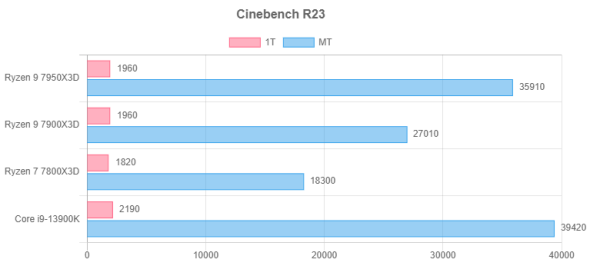
The results of all Ryzen 7000X3D processors match the theoretical difference in their peak performance completely. In single-threaded workloads, the 7900X3D achieved equal results with the 7950X3D, which is a very good result, while the 7800X3D, which does not have a chiplet with more powerful cores and additional cache, was expectedly inferior.
In multi-threaded performance, the 12-core processor reviewed today falls in between the 8- and 16-core models, which is consistent with its configuration.
The selected competitor, the Core i9-13900K, demonstrated better performance in both single-threaded and multi-threaded modes. This processor benefits from high frequencies and a high number of cores, as well as corresponding power consumption, which reflects Intel's advantage in tasks such as games with heavy multi-threaded workloads, where additional cache may not provide significant speedup.
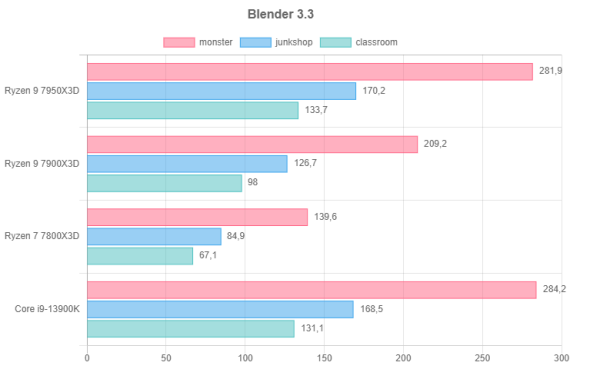
Our test scenes in Blender show slightly different comparative results, but overall the situation is similar: the advantage of the 7950X3D over the 7900X3D is approximately the same as that of the processor we are reviewing over the 7800X3D, based on the number of cores. The 12-core processor we are reviewing today performs decently, but the Intel processor chosen for comparison shows higher efficiency — at the level of the 16-core top-end Ryzen processor from the gaming series.

Another rendering test is Corona, which measures the time it takes to render one frame. The 16-core model with additional cache turned out to be the fastest, the 7800X3D is about half as slow, and the 7900X3D is noticeably closer to an older CPU than to an 8-core one. Thus, having 6 higher frequency cores without additional cache has a positive impact in such tasks. The price competitor Core i9-13900K in this test also outperforms the processor from AMD’s gaming series being reviewed today, being on par with the 16-core solution.

The latest 3D rendering benchmark is VRay, which measures the rendering speed of three scenes. The results of this test roughly follow the trend of the previous two: the Ryzen 9 7900X3D processor we are reviewing today is located approximately in the middle between the 7800X3D and 7950X3D. In this case, cores running at higher frequencies do not show a significant advantage over those with access to additional cache memory. The competing Intel processor also performed better than the two Ryzen gaming processors, although it was inferior to the current generation flagship. The heterogeneous architecture of Intel processors gives them a definite advantage, but the 7950X3D was still slightly faster in this test.
Working with photos and videos
The next testing section covers several programs for processing media data — photos and videos. These tasks are practical, such as exporting hundreds of high-resolution RAW images of approximately 3GB in size to Adobe Lightroom Classic. Such tasks are performed regularly by serious photographers.

In the photo processing test, AMD processors with additional cache turned out to be significantly slower than the 16-core model and almost equaled the 8-core version. This indicates that in a program like Lightroom, cores with lower clock speeds but larger caches are not efficient. The more cores on a chiplet without additional cache, the better the results. This confirms previous findings that processors without additional cache are recommended for users of digital content creation applications.
However, the competitor's generic processors showed the best results in this test among all AMD processors presented. This is explained not so much by the greater number of processing cores, but by higher efficiency in specific software, where multi-threaded performance does not play a decisive role, as in Adobe Lightroom.

In the video editor of the same company, the situation turned out to be different and corresponds to the theory. We tested the rendering of projects of varying complexity in Full HD and 4K formats — these are typical tasks when preparing an edited video for streaming video services, which makes the results more practical. The Ryzen 9 7900X3D took an intermediate position between the 7800X3D and 7950X3D, which shows that in this case 6 cores on the chiplet were enough. However, the price competitor represented by the Core i9-13900K was again ahead of the 12-core processor in question with additional cache, and even outperformed the 16-core model. The performance advantage of Intel processors was also evident in this aspect of working with the Adobe package.
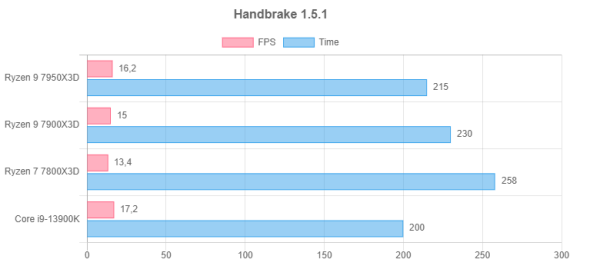
The next test in line is Handbrake, a package for converting video data to other formats. We took an H.264 video as input and transcoded it to H.265 — a typical task for modern users. The Ryzen 9 7900X3D performed between the 7800X3D and 7950X3D, but closer to the 7950X3D, highlighting the usefulness of high-clock cores in this task, while the chip with additional cache had a negative impact on performance. The Core i9-13900K was fast even compared to AMD's 16-core processor, due to its high clock speed and the importance of single-threaded performance in this test.
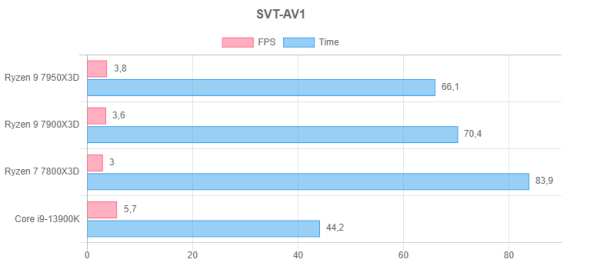
The second video transcoding test is SVT-AV1, which encodes video data into the AV1 format, a relatively new open standard. This time, the results of the Ryzen 9 7900X3D model under review also turned out to be predictable from a theoretical point of view — the lag behind the 7950X3D is less than the superiority over the 7800X3D. This is explained by the fact that in this test the frequency of the processing cores is crucial, which is reduced on a chiplet with an additional cache, while the 7800X3D uses only such cores.
The price competitor this time significantly surpassed all Ryzen models — optimization for a specific architecture is important, and the project used for tests has not yet been optimized for new AMD processors. As a result, today’s hero is significantly inferior to the Core i9-13900K we selected for testing. However, this only applies to this test, which is an exception.

The last test in this section is Topaz Video Enhance AI, an application used to improve video quality using artificial intelligence. This computationally challenging task involves high-quality resolution upscaling from Full HD to 4K using the Artemis High Quality algorithm. In this test, all Ryzen 7000 processors use the potential of Zen 4, including AVX-512 instructions, giving them an advantage over Intel solutions.
The 12-core processor in question with additional cache did not lose out to the 7950X3D as much as the 7800X3D, which emphasizes the importance of the maximum frequency of the processing cores in this test. Interestingly, even though the Core i9-13900K did not use AVX-512 instructions in this test for obvious reasons, the Ryzen 9 7900X3D processor could not outperform it — both processors showed approximately equal results.
Cryptographic tests
Another important area of processor performance testing is cryptographic tasks. Modern CPUs are capable of encrypting large volumes of information in near real time, and some support specialized instructions for common algorithms such as AES. The first test is John The Ripper — a free software for recovering passwords using hashes that takes advantage of all the capabilities of modern processors.
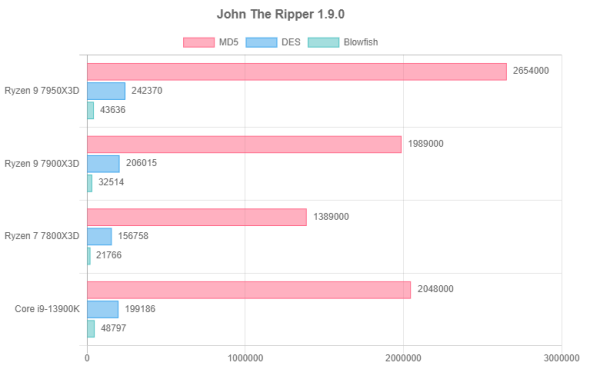
In cryptographic tests, the number of processing cores and the performance architecture with the maximum clock speed are critical, while the cache plays a less significant role. Therefore, it is not surprising that the 12-core processor with additional cache we are reviewing today is significantly inferior to the 16-core model, and the 7800X3D is even slower. The Ryzen 9 7900X3D demonstrated performance that was intermediate between 16- and 8-core models, which is in line with expectations. Compared to its competitor Intel, this processor was ahead of it in only one of three subtests (DES), and even then only slightly. In the case of the MD5 algorithm, the difference was also small, and in the Blowfish algorithm, the Intel processor was one and a half times faster — while even the 7950X3D was inferior to the Core i9.
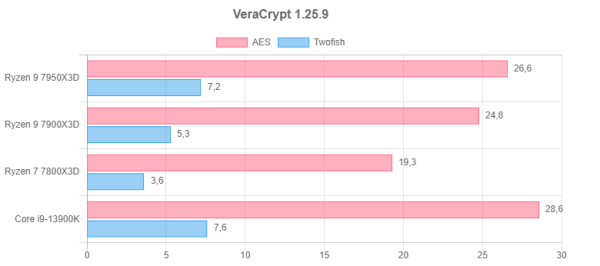
VeraCrypt is on-the-fly data encryption software that uses several different encryption algorithms and is capable of hardware-accelerated encryption on the processor. In our tests using a 1 GB buffer, the results were quite expected — the Ryzen 9 7900X3D processor took an intermediate position between the 7800X3D and 7950X3D, and in the case of the AES algorithm it was closer to the 16-core model. Compared to the Core i9-13900K processor, Ryzen was inferior in both tests — Intel's competitor has a higher number of cores and clock speed, which affected its performance.

The third and final cryptographic test is cpuminer-opt, a CPU mining program specialized in cryptographic calculations and well optimized for modern CPUs. As part of our tests, we selected the x25x algorithm used in some cryptocurrencies and compared the best result from several optimized miner options using instruction sets: SSE2, AVX2, AVX-512, as well as hardware support for AES and SHA.
The placement of the Ryzen 9 7900X3D in this test turned out to be typical, with performance between the 7800X3D and 7950X3D. Compared to the Core i9-13900K, the Intel processor also wins in three cases, despite the significant speed increase from using Ryzen's AVX-512 instructions. Thanks to more processing cores, including more efficient ones, in the Core i9, all AMD processors were inferior to the latest Intel flagship, and the additional cache could not provide an advantage here.
Compression and decompression
Compressing and decompressing data in archives is widely known among users, especially in the context of advanced archivers such as WinRAR, which is famous for its reliability and speed. To evaluate performance, we used the benchmark built into WinRAR, which measures the maximum data compression speed.

In WinRAR, AMD processors have always performed well in data compression tasks, especially models with additional cache, which was confirmed by tests of the Ryzen 9 7950X3D and 7800X3D. However, in this data compression benchmark, the Ryzen 9 7900X3D unexpectedly showed even slightly lower speed than the 7800X3D, despite the latter model's better technical characteristics. Perhaps the reason lies in the peculiarities of the division into 6+6 heterogeneous cores in the 7900X3D. The comparison with its competitor is similar — the Core i9-13900K demonstrated performance at the level of the 7800X3D, ahead of the 12-core Ryzen with additional cache being reviewed today.
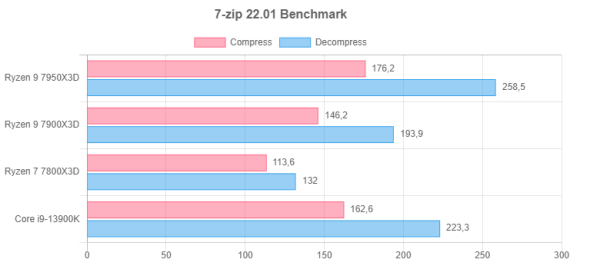
The second archiver, 7-zip, may be less popular, but it features support for a more efficient and demanding compression method. In tests using this archiver, the Ryzen 9 7900X3D again performed well between the 7800X3D and 7950X3D, confirming full utilization of all processing cores. However, the Core i9 outperformed the 7900X3D this time thanks to more cores and a higher operating frequency.
Math tests
The section, which is not the most extensive, dedicated to mathematical problems, includes Y-Cruncher, a program for calculating the number π. Of particular interest is this program's support for the AVX-512 instruction set and optimization for the Zen 4 architecture in the latest version that we used for testing.
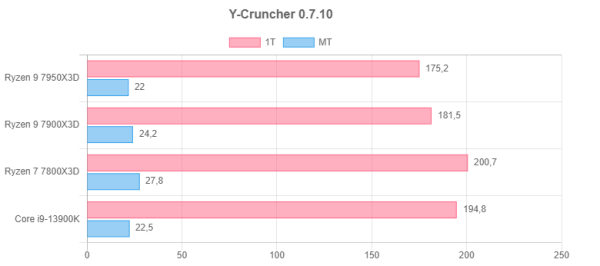
We tested the calculation of a billion digits of π in single-threaded and multi-threaded modes. In the single-threaded task, the Ryzen 9 7900X3D was slightly behind the 7950X3D due to the latter's slightly higher maximum core clock, while the 7800X3D performed even worse for the same reasons. The flagship of the previous generation Intel performed almost at the same level as the gaming 16-core AMD processor, despite the fact that Core processors usually show themselves stronger in single-threaded modes.
Multi-threading matters more to us, and here the 7900X3D's advantage over the 7800X3D has increased — a noticeably larger difference than between today's hero and the 7950X3D. In multi-threaded tasks, the Core i9-13900K is already behind the processor we are reviewing today, which is a little surprising given the significant number of processing cores in the Intel processor compared to the AMD gaming solution under review.
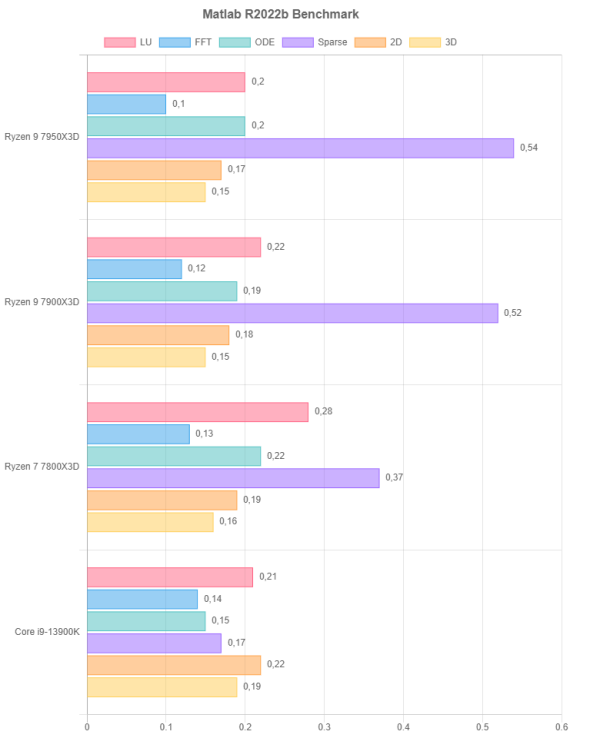
The built-in benchmark in Matlab is not ideal for evaluating performance, as it is outdated and runs too quickly on modern processors, and the results can vary significantly from run to run. The speed of the Ryzen 9 7900X3D is almost identical to the 7950X3D, showing minimal differences between the two. Comparing the Ryzen 9 12-core gaming processor with additional cache to the Core i9-13900K is difficult due to differences in results: the Intel processor has an advantage in some subtests, and AMD has an advantage in others. Therefore, we recommend that you pay attention to the results of scientific calculations from our 2020 test methodology, which includes longer and more informative tests in Matlab.
Gaming Performance
When it comes to gaming performance, our previous research included comparisons of different processor tiers based on performance and price, including two X3D models and a Core i9-13900K. The main conclusion was that even in modern games the difference between 8-core and 16-core processors with the same frequency is not so significant. For example, the 7800X3D may be even faster than the 7950X3D, and six fast cores are plenty for most games, especially given their per-clock performance, which significantly impacts results supported by more cache.
The Ryzen 9 7900X3D model reviewed today has six active cores on the chiplet with additional cache, which should theoretically allow it to demonstrate comparable results to other X3D models. However, it is worth noting that in games the advantage of a large L3 cache is not always clearly manifested. Our research showed that cache benefits are observed only in half of gaming applications, while in other cases it either has no effect, or cacheless processor models even show a slight advantage due to higher core frequencies on the chiplet without additional L3 cache.
Based on this, the Ryzen 9 7900X3D, with its six active cores and additional L3 cache in six chiplets, stands out among the X3D models, including the 7800X3D.
| Average FPS | Min. FPS | Avg., % | Min., % | |
|---|---|---|---|---|
| Ryzen 9 7950X3D (16C/32T) | 309.1 | 203.6 | 100% | 100% |
| Ryzen 9 7900X3D (12C/24T) | 300.8 | 199.8 | 97% | 98% |
| Ryzen 7 7800X3D (8C/16T) | 299.2 | 196.5 | 97% | 97% |
| Core i9-13900K (8P+16E/32T) | 307.1 | 202.7 | 99% | 100% |
We limited ourselves to four processors in the table, excluding less powerful solutions in order to focus on the comparison only with fairly powerful models from both manufacturers. Even with Full HD resolution and medium graphics settings, old and slow processors are significantly inferior to new CPUs. Models of the Ryzen 5000 and Core 11th generation families lag behind modern processors by 20%-30%, which is quite noticeable, despite the fairly high frame rate exceeding 200 FPS.
In the context of the 7900X3D processor and its differences from the 7800X3D and 7950X3D, all models with additional 3D V-Cache perform approximately the same. However, the speed boost from the additional 64MB of L3 cache varies among the games we tested. Examples of games that benefit significantly from larger L3 cache include Far Cry 6, F1 2022, Watch Dogs: Legion and Hitman 3. While games that do not benefit from larger cache such as Civilization VI and Total War Troy, mainly belong to the strategy genre.
When it comes to comparing the 7900X3D with the 7800X3D and 7950X3D, it posted an average FPS of the 7800X3D, while both lagged behind the 7950X3D due to the need for a large number of fast processing cores for some games. In any case, the difference was only 2%-3%, which is close to the measurement error and not significant.
| Average FPS | Min. FPS | Avg., % | Min., % | |
|---|---|---|---|---|
| Ryzen 9 7950X3D (16C/32T) | 152.4 | 115.5 | 100% | 100% |
| Ryzen 9 7900X3D (12C/24T) | 152.4 | 115.0 | 100% | 100% |
| Ryzen 7 7800X3D (8C/16T) | 151.0 | 113.3 | 99% | 98% |
| Core i9-13900K (8P+16E/32T) | 152.0 | 115.8 | 100% | 100% |
If we talk about a resolution of 2560x1440 at maximum rendering settings, the Ryzen 9 7900X3D practically does not lag behind its older 16-core brother 7950X3D, and the difference with the 7800X3D has decreased to 1%-2%. Thus, we can consider all X3D processors to be almost equal in terms of gaming performance (taking into account the use of not the latest test video card, of course).
The Core i9-13900K is also only slightly faster than the Ryzen 9 7900X3D on average, and this mainly concerns Full HD resolution at medium settings. In some games, one processor may have an advantage, while in others, another processor may have an advantage.
Overall, the gaming performance of the Ryzen 9 7900X3D is more than sufficient and is on par with the best processors on the market. This model does not suffer much from the fact that it only has six higher-frequency cores and six with additional cache, but with a lower maximum frequency. This is still one of the fastest gaming processors available today. However, it is worth noting that for resolutions of 2560x1440 and higher at high and maximum settings, players need processors of the Ryzen 5 and Core i5 level. The difference between the weakest and the fastest CPU can be difficult to notice in practice.
Power consumption and temperature
Estimating the power consumption of modern processors has become a complex and controversial issue. In the past, peak CPU power consumption was often determined by thermal design power (TDP or PL1), but with the advent of high-power processor models with different turbo modes, this has changed. Turbo modes allow you to exceed the rated power consumption for a certain time or even indefinitely, depending on many factors such as PL2, peak frequency limits, temperature characteristics and other parameters.
AMD and Intel have different approaches to defining and managing power consumption limits, which also affects the operation of turbo modes. Motherboard manufacturers can raise the consumption and voltage limits above those set by the CPU manufacturer, this is especially typical for top-end Intel processors, which can consume up to 300 W or more when the restrictions are removed.
With AMD's transition to the Zen 4 architecture and the new AM5 platform, performance has increased significantly, but power consumption and processor temperatures have also increased, even when using more advanced technical processes.
Our tests showed that the frequency of the Ryzen 9 7900X3D cores corresponds to the stated characteristics: the maximum frequency with single-threaded and dual-threaded loads reaches about 5.6 GHz, while with a full load on all cores it drops to 4.8 GHz. It's important to note that this is the upper limit for fast cacheless cores, while on-chiplet cores with additional cache operate at speeds up to 5.0 GHz.
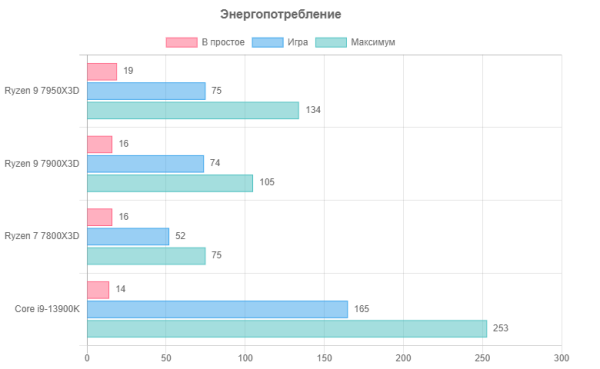
Estimating the power consumption of modern processors has become a complex issue, especially given the different turbo modes and consumption parameters. We ran tests in three different scenarios: idle, gaming load, and maximum consumption mode, using apps like Cinebench and Y-Cruncher to create the maximum load.
The Ryzen 9 7900X3D processor in question, like its brothers, has inflated TDP and PPT power consumption limits, but in practice it consumes much less. On our test system, it reached consumption of up to 105 W in multi-threaded tasks, and up to 75 W in games and other applications. This is due to the limitations of the chiplet with an additional cache, which does not support high voltages and frequencies. Actual consumption is noticeably lower than the established PPT limits of 162 W and TDP of 120 W.
Given its high gaming performance, the 12-core Ryzen 9 7900X3D can be considered an energy-efficient model. However, due to the sensitivity of the 3D V-Cache die to high voltage and heat, AMD has limited overclocking options and parameter changes, leaving only Precision Boost Overdrive and EXPO and XMP memory profiles.
A comparison with the flagship Intel Core i9-13900K in terms of energy efficiency shows a significant advantage of the Ryzen 9 7900X3D. Even in gaming mode, the 7900X3D's consumption is significantly lower than the 13900K's, highlighting its efficiency.
During idle time, the power consumption of all processors was low — a few watts. However, in game mode, the Ryzen 9 7900X3D consumed 74 W, which is close to the Ryzen 9 7950X3D's 75 W, but significantly lower than the 13900K's consumption.
Thus, the Ryzen 9 7900X3D processor demonstrates good energy efficiency with high performance in various operating modes.
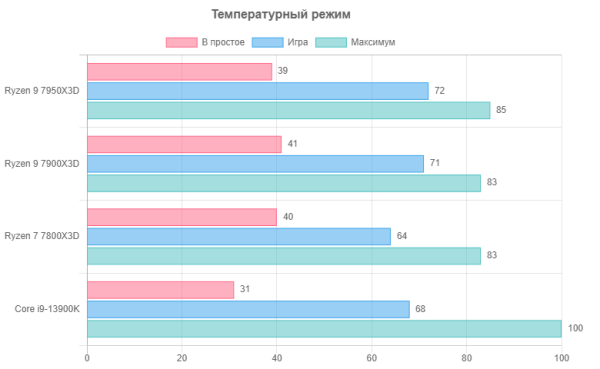
When it comes to thermals, the Ryzen 9 7900X3D exhibits similar performance to other X3D processors. Under maximum rendering load, the maximum core temperature reached 83°C, while in gaming mode it only slightly exceeded 70°C. It is important to note that to achieve such performance, a powerful liquid cooling system with a 360 mm radiator and three highly efficient fans was used. Using a conventional air cooler, it would be unlikely to maintain such low temperatures under prolonged load without the risk of thermal throttling.
At idle, temperatures of all processors, including the Ryzen 9 7900X3D, remained low, around 40°C, which is slightly higher than similar Intel processors. In gaming conditions, all compared processors ran moderately hot, but the Ryzen 9 7900X3D was one of the warmest. Interestingly, the cores of the Core i9-13900K, despite their larger size, heated up less, which is due to the better ability of the monolithic crystal to dissipate heat.
Like other processors in the X3D family, the Ryzen 9 7900X3D supports overclocking using Precision Boost Overdrive (PBO) technology and the ability to adjust the frequency curve and voltage Curve Optimizer. However, the multiplier does not support manual changes. Using PBO mode can increase performance by increasing power limits and optimizing the voltage curve, which may result in higher core temperatures. It is recommended that Ryzen 7000 users perform voltage optimization, which can be done either manually or using the Ryzen Master tool to automatically select the optimal frequency and voltage settings.
conclusions
The success story of processors with additional cache memory began with the introduction of the Ryzen 7 5800X3D, which became popular due to its high gaming performance and affordable price. Therefore, the release of X3D processors in the Ryzen 7000 family was an expected step, offering three models at once: the flagship 7950X3D, the popular 7800X3D and the ambivalent Ryzen 9 7900X3D.
The philosophy of the 7900X3D, with its configuration of six cores on a high-frequency chiplet and six cores on a chiplet with additional cache, seemed controversial: there might be few cores for games, and not enough for multitasking applications compared to 12-core models. However, experience has shown that the application performance of the 7900X3D is often in the middle between the 7800X3D and 7950X3D, sometimes even approaching the flagship thanks to the high frequencies of the cores without cache. In games, it performs almost the same as the 7800X3D, faster in some strategies where more cores are important than the 7800X3D. Thus, the 7900X3D represents a compromise between performance and price, which confirms its role in the market.
Although controversial on paper, the 7900X3D offers good value for money in practice. This processor can be a smart choice for those who need high gaming performance on a budget that exceeds the price of the 7800X3D, but falls short of the 7950X3D. However, keep in mind that it is less versatile than the 7950X3D and doesn't outperform the 7800X3D in gaming, and it costs more than the latter.
When choosing between Intel processors and the Ryzen 9 7900X3D, it's worth considering that while the latter is highly energy efficient and competitive in gaming, Intel processors can offer competitive alternatives in terms of performance and price, especially in demanding applications. However, the AMD AM5 platform promises support for new processors until 2025, which adds to the appeal of the Ryzen 9 7900X3D for those planning a future upgrade.

